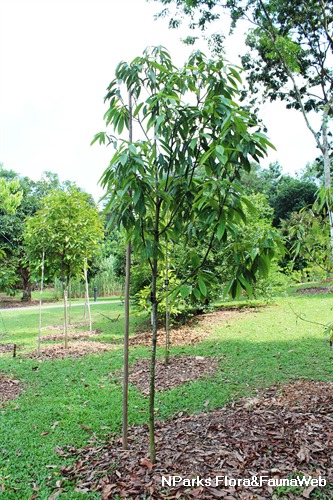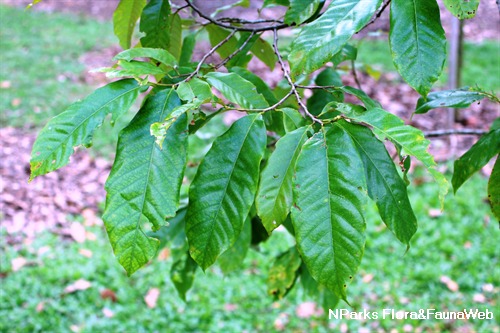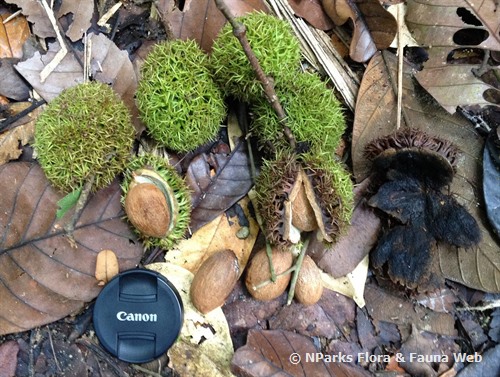
Back
Castanopsis inermis (Lindl. ex Wall.) Benth. & Hook.f.
| Family Name: | Fagaceae |
| Synonyms: | Castanopsis sumatrana |
| Common Name: | Braided Chestnut, Berangan, Berangan Betul, Berangan Makan, Berangan Padi, Parang Berangan |
Castanopsis inermis or Braided Chestnut is a tree from the Chestnut Family, often grows to 30 m tall. It has flowers clustered along a long stalk of up to 15 cm, each shoot may contain only female, male or bisexual flowers. Fruit contains up to 4 seeds, enclosed in a cupule, densely covered with reddish-brown hairs.
Name
Classifications and Characteristics
| Plant Division | Angiosperms (Flowering Seed Plants) (Dicotyledon) |
|---|---|
| Plant Growth Form | Tree (Medium (16m-30m)) |
| Lifespan (in Singapore) | Perennial |
| Mode of Nutrition | Autotrophic |
| Plant Shape | Irregular |
| Maximum Height | 30 m |
Biogeography
| Native Distribution | From Peninsular Malaysia and Singapore, to Indonesia |
|---|---|
| Native Habitat | Terrestrial (Primary Rainforest) |
| Preferred Climate Zone | Tropical |
| Local Conservation Status | Native to Singapore (Critically Endangered (CR)) |
Description and Ethnobotany
| Growth Form | It is a tree up to about 30 m tall with an irregular crown. |
|---|---|
| Trunk | Its grey bark is rough, with lenticels. |
| Foliage | Its spirally arranged, stalked leaves have leathery leaf blades that are inverse lanced-shaped and about 15–20 by 5.1–11 cm. The leaf blades are hairless above but with hairs beneath. |
| Flowers | Its clusters of male, female and bisexual flowering shoots are 10–15 cm long. Both male and female flowers may be solitary or in clusters of 3–7 (for male) and 3–4 (for female). |
| Fruit | A cupule encloses the fruit completely. Its depressed obovoid-globose cupule is 2–4 by 2–3 cm, with fine brownish-yellow hairs. The cupule has 3–4 lobes marked with curving bands that have thick tubercles. The fruit (nut) is 2–3 by 1.5–2 cm, and densely covered with reddish-brown hair. Fruits are also in clusters of 1–4, with the central fruit being rounded-triangular in cross section, while the smaller lateral fruits are egg-shaped or rounded. |
| Habitat | It grows in lowland forest up to 600 m altitude. |
| Associated Fauna | It has insect-pollinated flowers. It is also the preferred local food plant for caterpillars of the butterfly, the ciliate blue (Anthene emolus) and the moth Calliteara angulata. |
| Cultivation | It can be propagated by seed. |
| Etymology | Latin Castanopsis, resembling chestnut, referring to the relationship between this genus and Castanea (chestnuts); Latin inermis, without prickles, spines or thorns, referring to the unarmed fruits |
| Ethnobotanical Uses | Edible Plant Parts : Edible Seeds |
Landscaping Features
| Landscaping | The plant may be able to tolerate park conditions. |
|---|---|
| Landscape Uses | General, Parks & Gardens |
| Usage Hazard - Cons | Spines/Thorns - Fruit |
Fauna, Pollination and Dispersal
| Fauna Pollination Dispersal Associated Fauna | Butterfly Host Plant (Leaves), Caterpillar Moth Food Plant (Leaves) |
|---|---|
| Pollination Method(s) | Biotic (Fauna) |
| Seed or Spore Dispersal | Biotic (Fauna), Abiotic |
Plant Care and Propagation
| Light Preference | Full Sun |
|---|---|
| Water Preference | Moderate Water |
| Plant Growth Rate | Moderate |
| Rootzone Tolerance | Moist Soils, Well-Drained Soils |
| Propagation Method | Seed |
Foliar
| Foliage Retention | Evergreen |
|---|---|
| Mature Foliage Colour(s) | Green |
| Mature Foliage Texture(s) | Hairy / Hirsute, Leathery |
| Foliar Type | Simple / Unifoliate |
| Foliar Arrangement Along Stem | Alternate, Spiral |
| Foliar Attachment to Stem | Petiolate |
| Foliar Shape(s) | Non-Palm Foliage (Lanceolate) |
| Foliar Venation | Pinnate / Net |
| Foliar Margin | Entire |
| Leaf Area Index (LAI) for Green Plot Ratio | 3.0 (Tree - Intermediate Canopy) |
Non - Foliar and Storage
| Trunk Type (Non Palm) | Woody |
|---|---|
| Bark Colour(s) | Grey |
| Root Type | Underground |
Floral (Angiosperm)
| Flower & Plant Sexuality | Unisexual & Bisexual Flowers(Sub-dioecious) , Unisexual & Bisexual Flowers(Sub-dioecious) |
| Flower Colour(s) | Cream / Off-White |
|---|
| Flower Grouping | Cluster / Inflorescence |
| Flower Location | Axillary |
| Flower Symmetry | Radial |
| Inflorescence Type | Spike |
| Flowering Habit | Polycarpic |
Fruit, Seed and Spore
| Mature Fruit Colour(s) | Brown |
|---|---|
| Mature Fruit Texture(s) | Rough |
| Fruit Classification | Simple Fruit |
| Fruit Type |
References
| References | Soepadmo, E. (1972). Fagaceae. Flora Malesiana, ser. 1, Seed Plants, vol. 22, pt 2. Leiden: Naturalis Biodiversity Center. |
|---|
Image Repository
Others
| Master ID | 1497 |
|---|---|
| Species ID | 2790 |
| Flora Disclaimer | The information in this website has been compiled from reliable sources, such as reference works on medicinal plants. It is not a substitute for medical advice or treatment and NParks does not purport to provide any medical advice. Readers should always consult his/her physician before using or consuming a plant for medicinal purposes. |









.jpg)
.jpg)
_lowres.jpg)
_lowres.jpg)
_lowres.jpg)
_lowres.jpg)
_lowres.jpg)
_lowres.jpg)


